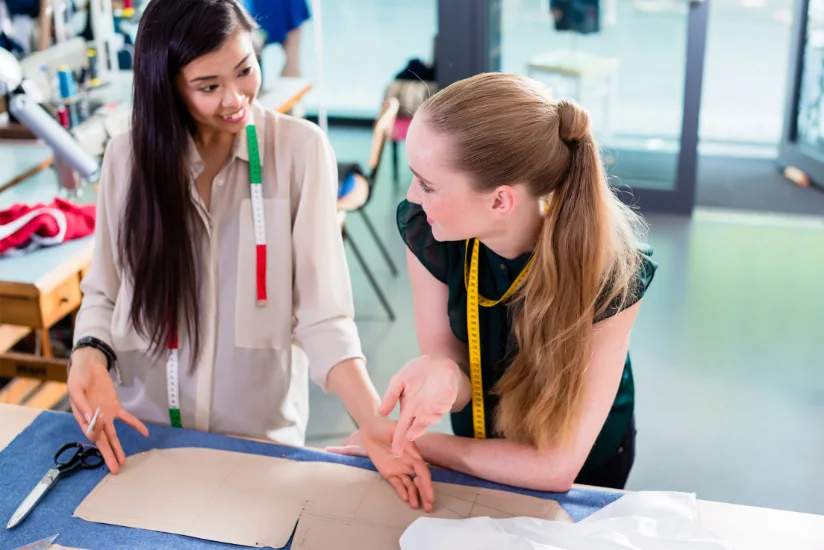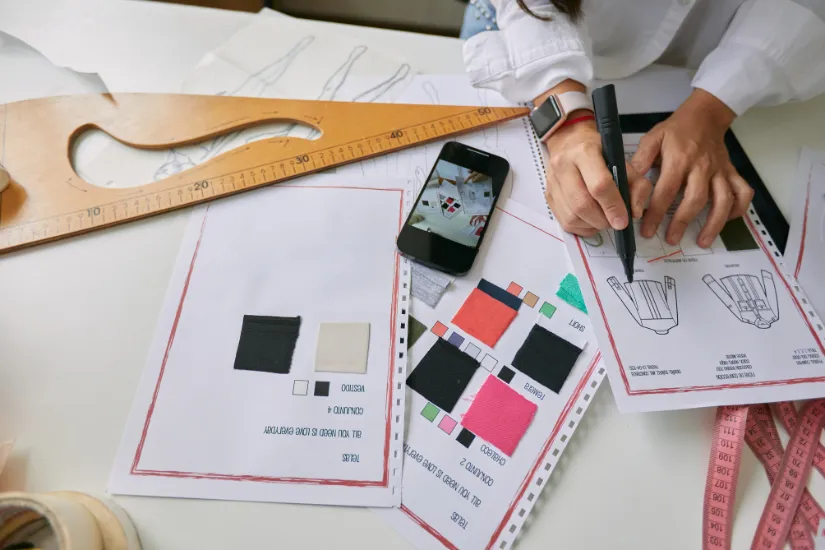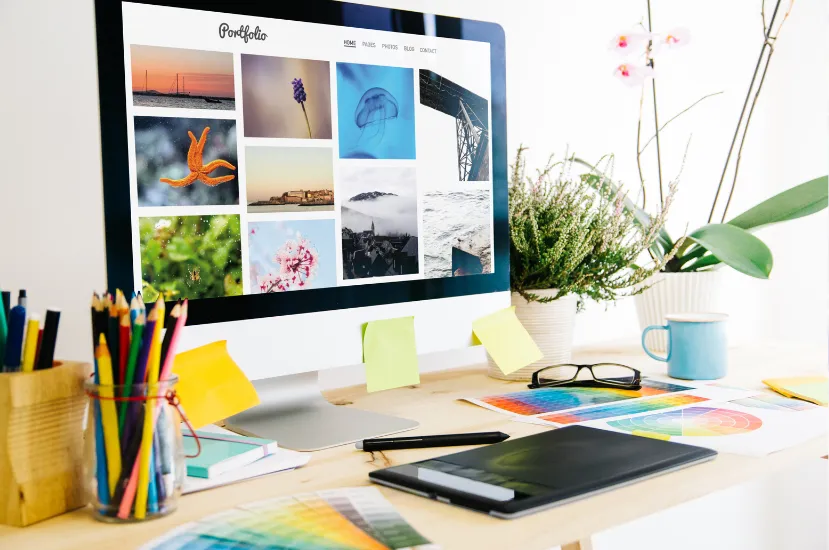A career in fashion design is very fantastic for a person who has a creative eye and a passion for clothes. The work of a fashion designer may seem hard to start but it is reachable with a great deal of work and passion for the field. We will try our level best to know about the details of being a fashion designer in this article. You will, therefore, be prepared to show off your bold creations to the people of the world.
Things to Watch Out for
You have to develop your sewing, designing, and drawing skills. Gaining experience in these areas through an internship or fashion design degree could be beneficial to your line of work. Concentrate on a specific field of design, such as haute couture or ready-to-wear.
You should develop your skills as much as you can by creating original designs. To become a fashion designer, this will help you comprehend your own stylistic vision more fully.
You can look into renowned fashion houses and designers to gain insight into the business and marketing aspects of the fashion industry and offer yourself a competitive advantage.
Here are some guidelines, tactics, prerequisites, and everything you need to fulfill your dream of becoming a prosperous fashion designer and how to become a fashion designer.
Read Related Story: What is the latest women’s fashion in the USA?
What Do Fashion Designers Do?

Creating and designing of clothes and accessories is the main work of a fashion designer. A few possible areas of fashion proficiency are to work on ready-to-wear, mass-market, sportswear, evening clothing, accessories, and footwear, etc.
Designers study fashion trends to create futuristic designs. They collaborate with designers on projects and often use design software to create components. At the beginning of the design process, fashion designers sketch, evaluate materials, and construct a prototype.
A trend or subject is emphasized in the fashion lines or collections that certain designers create. They produce goods for fashion weeks in New York, London, Paris, Milan, and other cities. While employed by these organizations, other designers build seasonal lines for well-known brands and offer proposals to creative directors.
In addition to their creative education, many designers also obtain instruction in business and marketing. Designers can sell their products to customers and get their pieces into retail establishments with the help of fashion merchandising experience.
Developing Your Skills

To become a fashion designer, you should develop your skills. Sketching, color and texture perception, and three-dimensional conception are skill sets of successful fashion designers. Above all, highly ambitious fashion designers will have to be proficient in a wide variety of stitching and cutting techniques for textiles.
You should never stop learning and honing your skills on a wide range of odd fabrics, patterns, and designs, even if you are a knowledgeable seamstress. Your skill in sewing in confined areas and with challenging fabrics will come in extremely handy in this field of work.
To become a fashion designer perfectly, you need to discover the characteristics of materials, including how they move, drape, breathe, and react when worn, and where they come from. Your in-depth knowledge of fabric is essential to choosing a fabric that works well with a certain design.
You must look into the histories, distinctive styles, and places of study of seasoned designers you admire to learn from them. Knowing this will help you improve as a designer overall by allowing you to build upon and borrow from their ideas.
You have to learn how to create storyboards and product ranges. To keep up with the latest fashions, you should check out store displays, social media trends, and runway presentations.
It’s advisable to start developing your skills in fashion design as soon as feasible. Gaining a comprehensive understanding of the fashion industry can be achieved gradually by learning a little bit every day. Trying to study everything at once will be too much to manage.
To become a fashion designer, you can consider obtaining a degree in fashion design. Studying fashion design or a related subject can teach you a lot about developing your abilities and networking with like-minded people. Gaining access to the expertise and feedback of noted professionals on your designs can help you become an incredibly talented designer. You may try either or both of the following:
You need to obtain a degree in fashion design. Most programs run between three and four years.
Two of the most noted design schools in the US are FIDM and Parsons. Apart from other practical skills, you must study color and composition, drawing, pattern-making, and draping.
Along with learning useful skills, you will be collaborating with industry experts who could turn into important contacts down the road. They can offer you advice and criticism on your work directly from the source. They also can help you gain practical experience.
Apply to work as an intern or apprentice. If you believe that an internship in the fashion sector would be more helpful for you than attending school, search for internships in the field. Applying will require you to have a solid portfolio and be willing to work your way up as interns are sometimes given menial tasks like getting coffee.
Don’t let little tasks demotivate you; the relationships you make during your internship or apprenticeship will be crucial as you pursue a career in fashion. Working with industry experts will also allow you to get priceless knowledge straight from the source.
Read Related Story: What are the best fashion tips for men and women?
Selecting a Field of Design

You can choose the design discipline that most interests you. It’s imperative to start by being very clear about which aspects of the fashion industry most appeal to you. When choosing a career route, you should consider the advantages and disadvantages of every design industry, including haute couture and mass-market retail. It’s a good idea to avoid taking on more than you can handle and to go cautiously. Nevertheless, you are not required to follow a particular style.
During choosing your career route, you should consider the advantages and disadvantages of every design industry. Even if, haute couture and mass market retail should be thought of. No doubt that it’s a good idea to avoid taking on more than you can handle. Moreover, you are not required to follow a particular style and to become a fashion designer.
As you grow and learn, you’ll have plenty of opportunities to find the type of design that best appeals to you as a fashion designer. For example, you may be interested in:
- Women’s attire throughout the day and at night
- Men’s daytime and evening attire
- What teenagers wear; what girls and males wear
- Sports, fitness, and leisure wear
- Knit apparel for outdoor activities and adventures.
- Wedding gowns
- Extras
- Costumes from the movie theater and film business
You can show your love of the trade ahead of your desired fame. You should remember that a great deal of perseverance, diligence, and effort are required to succeed in the fashion design industry. Successful fashion designers prioritize the needs of the average client because they purchase the majority of their items. Fashion brands frequently provide celebrities with free products in exchange for exposure, but it could be difficult to make ends meet without serving the broader public.
Find out what your clients need. Be honest: if you live in a really warm climate, selling ski jackets will be challenging. You should look at what real people are wearing to learn about their needs and desires. For example, everyday wearable practical things like shirts and pants tend to attract the attention of the average consumer. Remain grounded in reality and keep things simple. Exquisite paintings may seem amazing on paper, but fitted shirts and skirts will most likely be more popular than daring evening gowns.
To become a fashion designer, you should improve the designs you’ve created. If you plan to build a style more than a hundred times, be sure it is perfect before sending it to production. You will get better results and sell more of the piece if you explore more with the fabric, fit, and drape. Poorly constructed clothing that doesn’t fit well or is simply plain unsightly will cost you money in return.
Is a fashion design career best for you?

Before moving to build up a profession in fashion design, you might think about your personality and skills. You should strongly keep in mind that a good sense of style is not enough to succeed in the industry. Requirements include a high-stress threshold, strong work ethic, excellent communication skills, and the ability to take criticism. It could be quite difficult to build your brand. It does not make any impact if you move to cities with your designs, take on different jobs for different clients or bosses, and promote continuously. If you don’t find interest in working hard for branding, you should reconsider pursuing a career in fashion design.
To become a fashion designer, you would be most suited for a career in fashion design if you dream, and love fashion. You also need to possess a thorough understanding of the fashion industry and strong beliefs about what makes for good fashion.
Becoming a fashion designer is probably not for you if you cannot take stress, hate ambiguity, or instability. Do not want a career that has highs and lows all the time, requires a lot of supervision, or hates having unpredictable finances.
Setting Yourself for Achievement

You must know the fashion industry’s business side. You have also some facts like talent, originality, and a solid understanding of the business and marketing of the fashion industry. It would be best if you regularly read trade journals like Women’s Wear Daily to keep updated on industry developments.
Fashion design degrees frequently include lessons in marketing and financial literacy. It is important to carefully review the curriculum linked to the degree you choose, as certain majors and programs emphasize these helpful courses more than others.
You need to learn about topics beyond design. The fashion industry encompasses a full supply chain, and you need to know exactly what each person’s function entails to meet expectations, make concessions, and identify trouble spots.
In the society, there are so many varieties of people working in the fashion industry. Some of them are merchandisers, buyers, sample machinists, cutters, graders, quality controllers, salespeople, public relations and marketing personnel, fashion writers, merchants, stylists, and event planners.
You can learn about your customers. You should know their preferences, likes, dislikes, spending patterns, and lifestyles. If you are aware of the needs of the client, you will become a more competitive designer. You need to keep a watch on what other fashion designers in your area of interest are up to.
One excellent approach to learning about the inner workings of the fashion industry, including supply chains and production sites, is to visit trade exhibitions.
You have to look for a job in fashion design. Depending on your interest in design, you can take several ways to become a designer in the fashion industry. Be ready to accept a position that’s not exactly in your sector of interest in design, if only for the experience. Being flexible will help you land the job of your dreams as you gain more experience. You will need to persistently apply to many job ads to get your foot in the door. Here are some locations you can apply to start with:
Currently operating fashion companies and designers that are hiring for paid entry-level positions, internships, designer assistants, etc.
Parts for costumes used in movie theaters, costume stores, etc.
Online advertisements are being used in several job-search platforms, including Linkedin.
Word of mouth: To get admission, take advantage of your connections in academics or the fashion industry. This is a great way to start working in an industry that values the perspectives of influential people.
You need to retain financial discipline. You should closely monitor your per month earnings and spending. If you have the funds, it’s a great idea to have an accountant to manage the financial issues of your company.
No problem, if you do not want to manage your own company. There is an option to work as a designer for a fashion company.
You should consider your market when creating. If you’re passionate about designing bikini designs but live in a place that gets cold weather a lot, you might want to think about moving somewhere where the climate will support the success of your designs. Creating for your target market requires playing to the local way of life. For example, sales of dresses and shorts are higher in warmer climates, whereas sales of jackets are higher in colder climates. By creating for your target market or presenting your designs to other venues, you can improve your chances of selling the most items.
To become a fashion designer, you should think about the potential of Internet sales. Anyone, anyone can buy from you if your webpage is designed with ease of use and high-quality stock photographs. Living in a city where the fashion industry is booming is one of the best ways to start a career. France’s Paris, England’s London, the US’s New York, Italy’s Milan, Japan’s Tokyo, Spain’s Barcelona, Spain’s Madrid, South Korea’s Seoul, Canada’s Toronto, Brazil’s Sao Palo, Germany’s Berlin, India’s Mumbai are some cities rank among the top fashion capitals in the world.
What is a Guide for Creating a Fashion Portfolio?

A strong portfolio of designs is required for employment in the fashion industry. Many fashion designers start building their portfolios even before they apply to schools for programs. To display their skills and creations, students continue to add to their portfolios. Designers can mix ready-to-wear and custom high-fashion outfits in their portfolio to show off a variety of styles, or they can choose to emphasize their technical skills.
Over the course of their careers in fashion, designers update their portfolios. Through internships, part-time jobs, and stylist positions, people in the design industry can grow their portfolios.
So, you must create a portfolio out of your work. A well-organized design portfolio is crucial when applying to design positions and internships since it shows your level of experience and your ability to market yourself. You should display the designs that you’re most proud of and that best capture your skills and creativity. And you can select a premium binder to show that you take your responsibility as a designer seriously. You also should include the following elements in your portfolio:
- Computer-generated images of your artwork
- Hand-drawn illustrations
- Resume
- Pages with an idea or feeling
- Presentation pages featuring textiles or colors
- Any further works that highlight your skills or development to date
Where Can Fashion Designers Find Employment?

Fashion designers work with well-known fashion businesses in manufacturing and wholesale. In these roles, they make apparel and accessories that retailers purchase from businesses. About 25 percent of fashion designers work as independent contractors, creating designs for customers. Some of these designers launch their fashion brands or create high-end custom clothing.
The job frequently requires travel and lengthy hours. Designers often work long hours to complete fashion presentations or satisfy production deadlines. Most American fashion designers have their main offices in either Los Angeles or New York to become a fashion designer.
Information Regarding Fashion Designer Salary

The top-paid fashion designers earn more than $145,000 a year, which is more than the industry average. Salary varies based on industry and region. The aforementioned data illustrate that designers employed in the manufacturing and specialized design services sectors typically earn above $100,000 in pay.
Conclusion
Fashion design requires acute attention to detail. You should allow your senses to fully perceive the colors, patterns, and sensations present in the real world. Make a note of the things you observe and visualize your designs once they are sketched out on cloth.
You should learn from your competitors. You need to examine the kind of fasteners (such as zippers and buttons) that the comparison designers are using, along with the fabrics’ care, breathability, and comfort. Taking inspiration from your competitors is not copying and product research that helps you refine your style and make better items.
To become a fashion designer, you need to treat best-sellers with extreme caution. These “favorite” products are well-liked for a reason. It’s up to you to identify the unique qualities of these objects and use those components in your works.
To play to your strengths, you may focus on your strongest design skills. You now think about your design’s strong points. Perhaps you’re a wizard of yoga pants or an expert with accessories. Skilled fashion designers take advantage of their passions and skills while monitoring consumer tastes. To do this, you must pay careful attention to new trends and look for creative methods to improve your designs in fresh and engaging ways.

